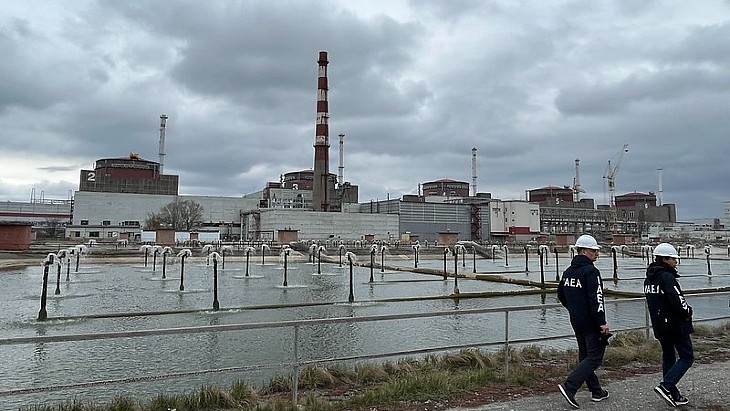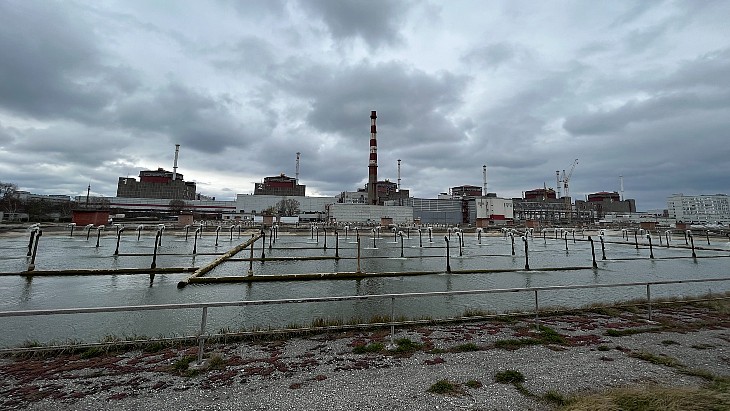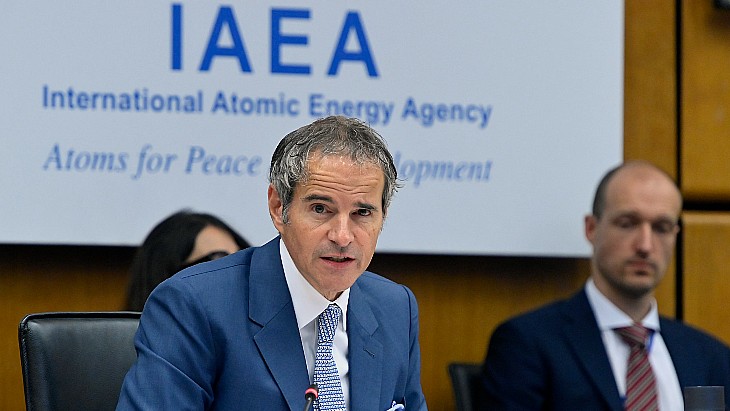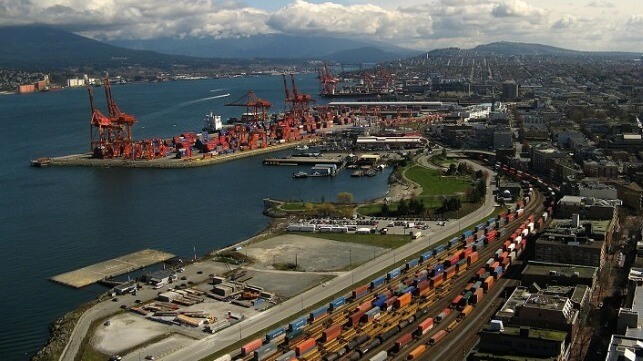Grossi to lead IAEA mission to Zaporizhzhia next week
07 June 2023
International Atomic Energy Agency (IAEA) Director General Rafael Mariano Grossi is to lead the latest rotation of its experts at the Zaporizhzhia nuclear power plant next week. It comes as the IAEA and nuclear experts in Ukraine and in Russia say there is no short-term risk to its safety and security as a result of the damaged Nova Kakhovka dam.
 It is estimated that there is enough water on site to last for months (Image: IAEA)
It is estimated that there is enough water on site to last for months (Image: IAEA)The dam was damaged early on Tuesday, prompting widespread flooding and evacuations. The Zaporizhzhia nuclear power plant - Ukraine and Europe's largest - is about 140 kilometres upstream from the dam so not in an area directly affected by flooding. But the damage has led to a fall in the level of the reservoir, which is used to supply cooling water to the plant.
In its latest update the IAEA reported that between 10:00 and 20:00 local time on Tuesday the reservoir fell by 83cm to 15.44 metres. If the level falls below 12.7 metres the plant will not be able to pump water to replenish its water at the site. It is an evolving situation, but that level could be reached within a day or two, the IAEA says.
However, this sort of fall in the reservoir levels is a scenario which has been planned for, including in stress tests carried out after the Fukushima earthquake and tsunami and also by Ukraine's nuclear operator Energoatom, at the request of the State Nuclear Regulatory Inspectorate of Ukraine (SNRIU), over the past winter. According to the head of SNRIU, Oleg Korikov, the measures outlined meant that the reservoir's lower water level "should not affect the state of nuclear and radiation safety of the Zaporizhzhya NPP, provided that these measures are implemented" and with the reactors remaining in their current shutdown state, which means a lot less cooling water is required.
In its update the IAEA said that, even when water levels are too low for the usual pumping system to operate, "the existing water in the ZNPP site’s sprinkler and cooling ponds as well as the adjacent channels can still be used for some time to cool the reactors and the spent fuel pools in the reactor buildings ... In addition, a large cooling pond next to the site - the main alternative source of water in the absence of the reservoir - is currently full and has enough in storage to supply the plant for several months as its six reactors are in shutdown mode".
"Also, if needed, the site can access a deep water-filled excavation in the ZNPP cargo port area, the water system of the nearby city of Energodar, and use mobile pumps and firefighter trucks to fetch water," it adds.
Restrictions on the use of water have been brought in to focus it on essential safety and cooling functions. Grossi added: "There is a preparedness for events like this ... which will help staff to handle this new challenging situation. But, clearly, this is making an already very difficult and unpredictable nuclear safety and security situation even more so."
Russia's Tass news agency reported a spokesman for the Nuclear Safety Institute of the Russian Academy of Sciences as saying "the water level in the reservoir supplying cooling water to the reactors is at a sufficient level and is being monitored. We are keeping a close eye on the situation ... the plant’s employees are in control of the situation."
Meanwhile Renat Karchaa, adviser to the CEO of Russia's Rosenergoatom, told Tass that the number of IAEA inspectors at the Zaporizhzhia nuclear power plant "will increase several times", confirming Grossi's comments to reporters earlier this week (before the dam was breached) that he wanted to "reinforce" and increase the size of the team, to reflect their wider reporting responsibilities in monitoring the five safety principles outlined at the UN last week.
Grossi had said he was not sure when the enlargement of the team would take place and that it might be at the next rotation - which he has said he will lead, and which will take place next week. Ukraine's President Volodymyr Zelensky said he discussed the situation at the plant with the IAEA director general, and agreed with Grossi on visiting Ukraine in the coming days.
In a separate development, the IAEA said that its experts at the Chernobyl site have reported a forest fire near the Paryshev village in an area not reachable from the Chernobyl side because of damage to a bridge. It is not assessed to be a major fire and, the IAEA says, "there has been no increase in the radiation levels reported to the IAEA International Radiation Monitoring Information System and the fire does not present any radiological risk to the population or staff working at the Chernobyl site".
IAEA: 'No immediate risk' to Zaporizhzhia from dam damage
06 June 2023
The International Atomic Energy Agency (IAEA) says the impact of the damage to the dam on cooling water supplies to the Zaporizhzhia nuclear power plant is being monitored but alternative sources of water on-site should provide sufficient water for cooling "for some months" and means "our current assessment is that there is no immediate risk to the safety of the plant".
 Water is essential for cooling functions. This picture was taken in March during an IAEA visit to the plant (Image: IAEA)
Water is essential for cooling functions. This picture was taken in March during an IAEA visit to the plant (Image: IAEA)In an update to the IAEA board of governors on Tuesday morning, Director General Rafael Mariano Grossi said the damage to the Nova Kakhovka dam - which Ukraine says was caused by the Russian shelling, and Russia blames on Ukraine - had led to a "significant reduction in the level of the reservoir used to supply cooling water" to Zaporizhzhia nuclear power plant.
The cooling water system at the plant is used for residual heat removal from the reactors (used or partially used fuel there), residual heat removal from the used fuel ponds and cooling of emergency diesel generators if and when they are running.
"Absence of cooling water in the essential cooling water systems for an extended period of time would cause fuel melt and inoperability of the emergency diesel generators," Grossi said.
IAEA staff at the plant have been told that at the moment there is a 5cm per hour reduction in the height of the reservoir, "the main line of cooling water is fed from the reservoir and pumped up through channels near the thermal power plant to the site. It is estimated that the water through this route should last for a few days".
The water level in the reservoir was about 16.4 metres at 08:00 local time - with the IAEA saying that if the level drops below 12.7 metres it can no longer be pumped. The damaged dam itself is about 140km downstream of the nuclear power plant.
There are also alternative sources of water, Grossi said: "A main one is the large cooling pond next to the site that by design is kept above the height of the reservoir. As the reactors have been shut down for many months it is estimated that this pond will be sufficient to provide water for cooling for some months. The agency will confirm this very shortly. It is therefore vital that this cooling pond remains intact. Nothing must be done to potentially undermine its integrity.
"I call on all sides to ensure nothing is done to undermine that."
The IAEA team at the site say that the nuclear power plant is "making all efforts to pump as much water into its cooling channels and related systems as possible" and non-essential consumption of water stopped.
He said that he already planned to visit the Zaporizhzhia nuclear power plant next week "and now it is essential. I will go".
The damage to the dam, which is in a Russian-controlled region, has led to severe flooding and mass evacuations. According to the Russian Tass news agency as of 09:30 GMT on Tuesday, "14 settlements with a population of 22,000 people have come within the flooding area ... and a total of about 80 villages may be inundated". According to Ukrinform, at 14:00 local time (12:00 GMT) the water level in the reservoir had dropped by 1.5 metres.
The Zaporizhzhia nuclear power plant is the largest in Ukraine, and Europe, with six reactors. It has been under Russian military control since early March 2022. Five of its six reactors are in cold shutdown and one in warm shutdown - which allows it to provide heat for the plant and the nearby city of Energodar. As it is upstream of the reservoir it is not in the areas at risk of flooding.
A failure of the Nova Kakhovka dam caused by an earthquake was a scenario examined in post-Fukushima Daiichi safety checks of the Zaporizhzhia plant, in particular the possibility of water loss in the cooling pond, and concluded that "owing to the significant width of the cooling pond levee ... water losses because of filtering will remain actually unchanged in comparison with the design-basis conditions".
Sama Bilbao y León, director general of World Nuclear Association, welcomed the fact the nuclear power plant "remains in a safe, stable situation" despite the damage to the dam, adding: "The analysis and planning done in preparing the plant’s safety case, including revisions carried out as part of the plant’s stress tests, have ensured the plant is both robust and prepared to handle challenges, such as those resulting from the rupture of the Kakhovka hydroelectric dam.
"I condemn outright the deliberate attack on the dam. Beyond the disruption to operations at Zaporizhzhia, the attack has caused a threat to life for the thousands of residents downstream of the dam, as well as the destruction of property and farmland, and environmental damage."
IAEA aims to expand team at Zaporizhzhia
05 June 2023
International Atomic Energy Agency (IAEA) Director General Rafael Mariano Grossi has said he hopes to "reinforce" the agency's team of experts at the Zaporizhzhia nuclear power plant to reflect its expanded role which includes monitoring compliance with the five safety and security principles outlined at the United Nations last week.
 (Photo: D. Calma/IAEA)
(Photo: D. Calma/IAEA)
In his statement to the IAEA board of governors, Grossi said he had "respectfully and solemnly asked both sides to observe" the five principles - which include agreement not to fire from, or at, the nuclear power plant, or to use it as a base for military personnel or equipment that could be used for an attack.
He said: "They are to no-one’s detriment and to everyone's benefit ... the IAEA Support and Assistance Mission to Zaporizhzhya (ISAMZ), will report to me, in my capacity as director general, on the observance of these principles, and I will report publicly on any violations of them."
At a news conference following his statement to the board, Grossi was asked when the team at the Zaporizhzhia plant was to be expanded. He said the precise timing was not the key thing, as the "wider mission" was now already in place but his aim was to reinforce the team, and enlarge it, perhaps at the next rotation of staff.
Zaporizhzhia is the largest nuclear power plant in Ukraine, and Europe, and is on the frontline of Russian and Ukrainian forces. The wider site has been damaged by shelling at times over the past 16 months of war and it has also had to rely on emergency diesel generators on seven occasions when it has lost its external power supply.
Grossi said: "The site’s fragile power situation continues to be a source of deep concern and - as the newly-established IAEA principles indicate - there is a need for intensified efforts to ensure a more stable and predictable external electricity supply."
The plant currently relies on one 750 kilovolt power line for the external electricity it needs for reactor cooling and other essential nuclear safety and security functions, compared with the four off-site power lines available before the conflict.
The nearby Zaporizhzhia Thermal Power Plant operates the 330 kV open switchyard, through which back-up power has been supplied in the past and Russia told the IAEA in March that Rosatom was working to remove damaged equipment from the open switchyard, "with the aim of restoring three 330 kV lines to the grid system in currently Russian-controlled territory" but, the IAEA said, its experts have still not been granted access to assess the situation and "consultations are ongoing to secure the access".
In his broader update to the IAEA board of governors, Grossi said EUR5 million (USD5.35 million) of nuclear safety and security equipment had been delivered to Ukraine and so far 81 of its experts in 37 missions had been part of one of the rotations at the country's five nuclear sites.
On safeguards to avoid nuclear proliferation, he said that the AUKUS plan - involving the USA and UK - for Australia to get nuclear-powered submarines was "of considerable interest and, for some, concern" and he said the "Secretariat has engaged in consultations with the states concerned to consider the possible implications on the application of agency safeguards. Such arrangements must be in strict conformity with the existing legal framework and, once they are finalised, will be transmitted to the Board of Governors for appropriate action. This process will take some time and the agency will undertake it with its technical, impartial and objective approach."
On Iran, in response to questions from reporters, Grossi rejected the suggestion that safeguards had been "watered down" and insisted that the IAEA was "firm but fair". On North Korea, he said: "The reopening of the nuclear test site is deeply troubling. The conduct of a nuclear test would contravene UN Security Council resolutions and would be a cause for serious concern."
He said that his recent, first official, trip to China had led to the establishment in Beijing of the Nuclear and Radiation Safety Centre. "The centre will be a place for Member States to cooperate and share knowledge on fundamental topics such as ensuring radiation safety, transporting nuclear waste and promoting capacity-building. This visit was of fundamental importance as we enhance our bilateral work in the context of China’s fast-growing civil nuclear programme," he said.
Meanwhile, he said, the Rays of Hope cancer initiative "is gaining momentum" raising approximately EUR37 million in the past year, but there were still funding gaps that need to be filled with 60 member states identifying additional estimated priority needs of EUR36 million.
Researched and written by World Nuclear News
.jpg?ext=.jpg) The signing of the letter of intent between OPG and OSGE (Image: OSGE)
The signing of the letter of intent between OPG and OSGE (Image: OSGE) It is estimated that there is enough water on site to last for months (Image: IAEA)
It is estimated that there is enough water on site to last for months (Image: IAEA) Water is essential for cooling functions. This picture was taken in March during an IAEA visit to the plant (Image: IAEA)
Water is essential for cooling functions. This picture was taken in March during an IAEA visit to the plant (Image: IAEA) (Photo: D. Calma/IAEA)
(Photo: D. Calma/IAEA)



